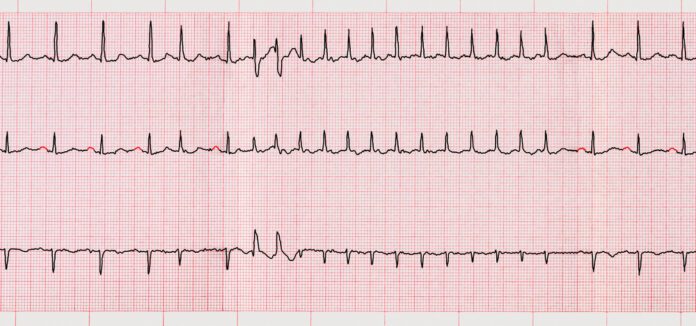Overview
Atrial fibrillation (also called AF or A-Fib) is the most common type of irregular heartbeat (arrhythmia) , occurring in 1-2% of the general population.
An arrhythmia is a problem with the speed or rhythm of the heartbeat. The cause is a disorder in the heart’s electrical system.
Atrial fibrillation occurs when electrical signals in the heart’s upper chambers (atrium) cause the atrium to beat quickly and erratically, causing an irregular fast heart rhythm. As a result, the heart may not be able to pump enough blood around the body or out of the atrium completely with each heartbeat. If not correctly treated, atrial fibrillation can lead to heart failure. People with atrial fibrillation also have 5 times higher risk of a potentially fatal stroke as the condition can cause blood clotting that blocks the artery supplying blood to the brain.
It is a problem that increases with age, with approximately 5-15% of people between 80-90 years of age affected. There is also an increased risk of atrial fibrillation among people with heart conditions, including irritation of the membrane surrounding the heart (pericarditis), heart muscle disease (cardiomyopathy), abnormal heart valves, or congenital heart defects.
Cause
When working well, the 4 chambers of the heart contract (squeeze) in an organized way.
Electrical signals direct your heart to pump the right amount of blood for your body’s needs. The signals begin in an area called the sinoatrial node (also called the sinus node or SA node).
In atrial fibrillation, the electrical impulse of the heart is not regular. This is because the sinoatrial node no longer controls the heart rhythm.
• Parts of the heart cannot contract in an organized pattern.
• As a result, the heart cannot pump enough blood to meet the body’s needs.
In atrial flutter, the ventricles (lower heart chambers) may beat very rapidly, but in a regular pattern.
These problems can affect both men and women. They become more common with increasing age.
Common causes of atrial fibrillation include:
• Alcohol use (especially binge drinking)
• Heart attack or heart bypass surgery
• Heart failure or an enlarged heart
• Heart valve disease (most often the mitral valve)
• Medicines
• Overactive thyroid gland (hyperthyroidism)
• Pericarditis
Symptoms
When you experience AFib, you may feel:
•Fluttering or rapid heartbeat (heart palpitations)
•Fatigue
•Dizziness or lightheadedness
•Shortness of breath
You can live a healthy, active life with mild atrial fibrillation. However, if symptoms worsen or begin to happen more frequently, it is important to have AFib treated to reduce the risk of stroke or heart failure.
Treatment
Treatment options may include one or more of the following:
• Medications
‣slow the heart rate (rate control)
‣control the rhythm (rhythm control)
‣reduce the risk of blood clots that form and cause blockage of vessel supply to any part of the body but especially the brain.
• Electrical cardioversion is used to restore a normal rhythm to the heart immediately and is only used in urgent conditions. This procedure cannot prevent a recurrence of atrial fibrillation. A regular rhythm has to be maintained through either long-term medication or ablation.
•Radiofrequency ablation or cryoablation is used to eliminate the abnormal signals that cause atrial fibrillation. This procedure restores the normal heart rhythm immediately and prevents any recurrence of atrial fibrillation in the future.
If medicines don’t work or they cause side effects, you can try one of two procedures called cardioversion or ablation. These treat AFib without surgery.
Other
Exams and Tests
The health care provider may hear a fast heartbeat while listening to your heart with a stethoscope. Your pulse may feel fast, uneven, or both.
The normal heart rate is 60 to 100 beats per minute. In atrial fibrillation or flutter, the heart rate maybe 100 to 175 beats per minute. Blood pressure may be normal or low.
An ECG (a test that records the electrical activity of the heart) may show atrial fibrillation or atrial flutter.
If your abnormal heart rhythm comes and goes, you may need to wear a special monitor to diagnose the problem. The monitor records the heart’s rhythms over a period of time.
Event monitor (3 to 4 weeks)
Holter monitor (24-hour test)
Implanted loop recorder (extended monitoring)
Tests to find heart disease may include:
- Echocardiogram (ultrasound imaging of the heart)
- Tests to examine the blood supply of the heart muscle
- Tests to study the heart’s electrical system
Source
https://www.nhlbi.nih.gov/health-topics/arrhythmia
https://www.bumrungrad.com/en/conditions/atrial-fibrillation



